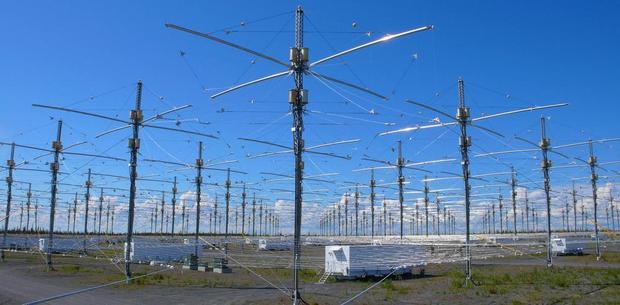
The shutdown of HAARP, a project created by the late Sen. Ted Stevens when he wielded great control over the U.S. defense budget, will start after a final research experiment takes place in mid-June, the Air Force said in a letter to Congress Tuesday.
The University of Alaska has expressed interest in taking over the research site, which is off the Tok Cutoff in an area where black spruce was cleared a quarter-century ago for the Air Force backscatter radar project that was never completed. But the school has not volunteered to pay $5 million a year to run HAARP.
Responding to questions from Sen. Lisa Murkowski during a Senate hearing Wednesday, David Walker, deputy assistant secretary of the Air Force for science, technology and engineering, said this is "not an area that we have any need for in the future" and it would not be a good use of Air Force research funds to keep HAARP going. "We're moving on to other ways of managing the ionosphere, which the HAARP was really designed to do," he said. "To inject energy into the ionosphere to be able to actually control it. But that work has been completed."
Comments of that sort have given rise to endless conspiracy theories, portraying HAARP as a superweapon capable of mind control or weather control, with enough juice to trigger hurricanes, tornadoes and earthquakes.
Scientists say all of that is nonsense, and that the degree of ionosphere control possible through HAARP is akin to controlling the Pacific Ocean by tossing a rock into it.
Built at a cost of more than $290 million, the site has 180 antennas on 30 acres that are used to direct energy into the ionosphere, which is 55 miles to 370 miles above the Earth, and monitor changes in the flow of charged particles. Stevens was the godfather of HAARP, which he helped start two decades ago with annual earmarks slipped into the defense budget.
At the hearing on defense research and innovation, featuring six representatives of the Pentagon, no one said HAARP has a future in the defense budget.
Walker said the Air Force has maintained the site for several years and the last project is one by the Defense Advanced Research Projects Agency (DARPA). Once completed, the site will close.
DARPA Director Arati Prabhakar said, "The 'P' in DARPA is projects. We're not in the business of doing the same thing forever, so very naturally as we conclude that work, we're going to move on. It's not an ongoing need for DARPA despite the fact that we had actually gotten some good value out of that infrastructure in the past."
Walker said the Air Force would like to remove critical equipment this summer to avoid the expense of winterization.
Alan Shaffer, assistant secretary of defense for research and engineering, said HAARP is a "world-class facility," but the department does not need it anymore.
"With all the other issues and problems and challenges facing the department at this time, we just don't see that that investment, over a long-term period, is where we would prioritize our investment," said Shaffer.
"No one else wants to step up to the bill, ma'am," Shaffer said to Murkowski.
On another topic, Murkowski asked Shaffer about small modular nuclear reactors for remote areas. She said, for example, Eielson Air Force Base could benefit from "reliable energy security that nuclear power can provide."
Shaffer said the "sticker shock" of an initial $1 billion investment for a small nuclear reactor is a huge obstacle.



Job Done! I can imagine "High Fives" all around and slapping on the back. We have a world that is in Chaos regardless of the country or continent we live in.
They have destroyed our bodies with food that is not fit for human consumption, they have destroyed our health with pharmaceuticals that are supposed to heal but destroy health, they have destroyed the earth with GMO'S using the living organisms that share this world with us. They have destroyed the very living earth beneath us by penetrating "Mother Earth" to extract it's riches and resources for profit.
So what is left, the very SOUL of humanity, that indefinable source that no philosopher in ancient or modern times has really been able to define, That source that links to the divine and to everyone of us that can use the term human.
It is said that we are EM beings, our heart and brain uses this energy. There is enough evidence to confirm this fact.
From the article
"We're moving on to other ways of managing the ionosphere
The ionosphere is full of EM energy, I am curious, have they created some "thing" that can destroy the very soul of humanity, that will make us into a "Zombie".
Just my Conspiracy mind at work and using my imagination, after all I am living in a dream so some say.